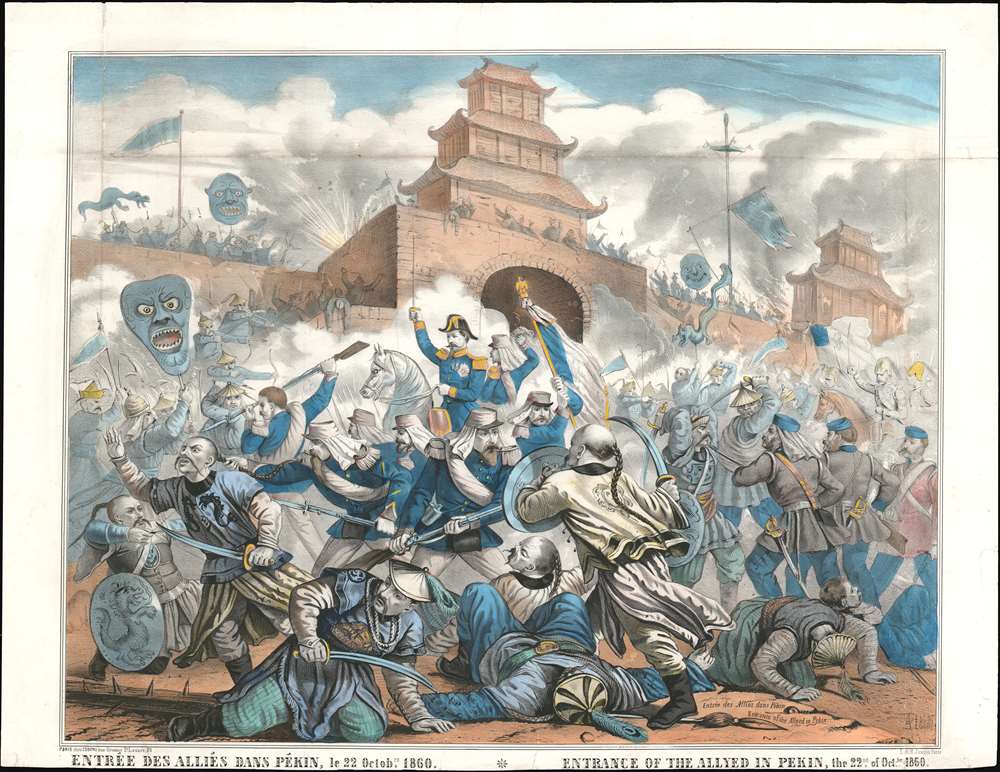This item has been sold, but you can get on the Waitlist to be notified if another example becomes available, or purchase a digital scan.
1860 Albert Chromolithograph View of the Allies Entering Peking (Beijing), China
PekingChina-albert-1860
Title
1860 (dated) 21.5 x 28 in (54.61 x 71.12 cm)
Description
A Closer Look
Brutal hand-to-hand combat fills the image. Chinese soldiers carry sabers, while British and French soldiers are armed with rifles and bayonets. Chinese archers take aim from the city's walls. Other Chinese soldiers bear large portraits of fearsome demons. Chaos reigns, and smoke obscures all but those in the foreground.The Second Opium War and the 1860 Franco-British Expedition to China
The Franco-British Expedition to China was the final action of the Second Opium War (1856 - 1860). The British and French had occupied Canton (Guangzhou) since late 1857. A brief interlude took place from May 1858 until June 1859, when hostilities recommenced because the Chinese refused to abide by the humiliating terms of the June 1858 Treaty of Tianjin. Battles were fought in June 1859 and recommenced in the summer of 1860, when a joint-Franco-British force marched on Peking after landing nearly 18,000 troops near Beitang. This European army won a string of victories, forcing the Xianfeng Emperor to send emissaries for peace talks, which was a delaying tactic. The British diplomatic envoy insulted his Chinese counterpart, leading to his kidnapping, torture, and execution by lingchi, a brutal flaying procedure also known as 'death by a thousand cuts' and 'slow slicing.' After this diplomatic incident, the Europeans continued their march on Peking. The Emperor fled the city and left his brother to negotiate peace. While negotiations were going on, British and French troops looted both the Summer Palace and the Old Summer Palace. During this war, British and French troops never entered Beijing. Once peace was declared, the diplomatic prisoners (or what was left) were returned, and their condition enraged the British. In reprisal, British General Lord Elgin wanted to burn the Forbidden City, but it was deterred by a Russian envoy. A French diplomat convinced Elgin that burning the nearby Summer Palace was the appropriate and 'least objectionable' response. The burning of the Summer Palace is remembered as one of the great cultural losses in history, comparable to the sacking of the Great Library of Alexandria and the destruction of the Bamyan Buddhas.Chromolithography
Chromolithography is a color lithographic technique developed in the mid-19th century. The process involved using multiple lithographic stones, one for each color, to yield a rich composite effect. Oftentimes, the process would start with a black base coat upon which subsequent colors were layered. Some chromolithographs used 30 or more separate lithographic stones to achieve the desired effect. Chromolithograph color could also be effectively blended for even more dramatic results. The process became extremely popular in the late 19th and early 20th centuries when it emerged as the dominant method of color printing. The vivid color chromolithography produced made it exceptionally effective for advertising and propaganda imagery.Publication History and Census
This view was drawn by Albert and lithographed by Henri Jannin in 1860 and sold in Paris. This is the only known surviving example.Cartographer
Henri Jannin (January 4, 1816 - 18xx) was a French lithographer and printer. Born in Lyon, Jannin opened his own printing firm in 1839. He was worked extensively for game designer Jules Xavier Matenet. In 1841, he as put on trial for not printing his name and address on his products, and also for printing socialist propaganda lithographs. He was fined 6,000 francs in May 1850, but it was reduced to 1,000 in November. In 1864, and again in 1867, two major commissions were created by Jannin and then printed by another firm, suggesting that Jannin may have gotten out of the printing business sometime in the early 1860s. More by this mapmaker...

